|
|
The NAQCC May 2015 Challenge All challenge info such as rules are now in the hands of Gary K1YAN. Email him with any questions in that regard at The results on this page are the responsibility of Hap K7HAP. Email him with any questions in that regard at PREMISE: Back in the day, it was common to hear "RIG HR HB 6V6"... "PADDLE HB, TWO J-38S BACK TO BACK"... "VFO MODIFIED ARC-5"... Our gear often came from junk boxes fed by old TV sets and junked BC radios. The kit rigs, by Heathkit, EICO and others, had become popular choices, and of course there was all that good surplus gear from Uncle Sam. Today our rigs with "basic necessities", such as DSP, stacked memories and multi colored displays, have raised complexity to the point where HB is not often heard any more and diving in under the hood may cause more problems than it cures. Lets go back this month. Do you have a kit or scratch built, rig, antenna, key or station accessory that could use some exercise? This is the time to bring it out and make some QSOs. TIME FRAME: The first day of the month 0000Z through the last day of the month 2400Z RULES: Make 10 QSOs (subject to the General Challenge Rules) during the time period using a home brew or kit piece of gear for each QRP QSO. This may be a rig, tuner, key, antenna or station accessory. It is not necessary that the station worked be using any home brew gear or be QRP. In the spirit of homebrew, please make it something that you personally built or at least did a significant part of the work. Since we do have to draw a line somewhere to say what qualifies as homebrew gear, modular kits (eg. the KX3) and items such as store bought antennas which only require cutting to length and connecting coax and end insulators, do not qualify as home brew gear for this challenge. Please check out your rig and see what it sounds like on the air. Remember chirps, yoops and drifting around a few kHz during each over are no longer as accepted as they were in the 60s! AWARDS: A certificate and Participation Point go to everyone making 10 HB QSOs and submitting their report before the deadline. A Participation Point goes to everyone making at least 1, but not all 10 HB QSOs and submitting their report before the deadline. PRIZES: A choice of an item made by master woodworker Gregg WB8LZG as shown on our prizes page here goes to someone selected via a random drawing from all who participate and submit a report for this month's challenge. A person can only win once, then they become ineligible for future drawings. LOGS: For your report, just tell us you either made the required 10 homebrew/kit QSOs or if you didn't make 10, then tell us how many you did make. If you think that your HB gear is a bit different (everybody has seen a K1 or HW- 8) and interesting send a digital picture we may post in the NAQCC newsletter challenge section to You may also include comments about the challenge. Please preface any comments you want posted with "SOAPBOX:" so we will know what you want posted and what is private. Send your results to: E-mail: You must type that address into your email program. Subject must read: (your call) NAQCC (month) Challenge For example: K3WWP NAQCC February Challenge Postal mail: Hap - K7HAP 8532 Canterbury Dr. Annandale, VA 22003 All entries must be RECEIVED before the 10th of the following month at 2400Z. Final Results: 10 HB QSOs K3WWP KD0V KD6SX N1J1 NQ2W KG4LLQ MW0RSS/A KB1UOH WI5H N0WKZ PA0XAW K9JWV N8XMS W2JAZ WA8AXF K1IEE PA1B K1YAN KA4WJB DH0DK W2JEK AB9YC AK3X K8UDHAll the above get a certificate and participation point. All below get only a participation point. K0FNR 5 QSOs WB3T 8 QSOs VE3FUJ 7 QSOs Soapbox: K3WWP: I made the required 10 QSOs in the first 1 hour and 40 minutes of May using a homebrew antenna switch and two homebrew antennas. All QSOs were DX - 9 from Europe and 1 from Asia. 9 on 20 meters and 1 on 30 meters. Perhaps the quickest I've ever completed a challenge. I wanted to make it in a hour, but came up short. I got #9 1 hour and 1 minute into May, then ran out of luck and took another 39 minutes to get the last one. Now with that out of the way, I can work on the European chapter challenge. BTW, if anyone is interested, the stations worked were: AO150E, OM2VL, UX7IW, 9A50AJ, AO150O, HA8WZ, E77A, MM0KLR, UA9MA - ALL on 20M, then AO150O again on 30 meters. KD0V: I have made 10 two QSO's using a NorCal 40A I build from a kit and a homebrew Center Fed Double Double Extended Zepp at 50 feet. I have made 10 QSO's using this setup between 0000Z and 2230Z on May 1, 2015. The NorCal 40A puts out 2 watts. KD6SX: This was a fun challenge. Perhaps, next time, we should shoot for 20 QSOs to make a bit harder. N1JI: This is the first challenge I've completed in less than a week! Nothing fancy here; I used a homebrew doublet and my paddles were made out of a piece of wood and some paper clips. KG4LLQ: Here's the details of my station which I am using for the May 2015 Challenge. My transceiver is an Oak Hills Research OHR-100a which I built from a kit. The power supply is a simple "wallwart" switching 12 vdc supply scavenged from an old H/P printer. Since the power supply output is 12 vdc, the power output of the OHR-100a is limited to 4 watts (with a 13.8 vdc power supply, my OHR-100a will produce 5 watts). I have two "shacks". My main shack in my basement consists of many pieces of QRO and QRP equipment. However my exclusive QRP station is up-stairs in a small den. It consists only of the OHR-100a, straight key, set of headphones, power supply and antenna connection. The attached photo is of my exclusive QRP station showing the equipment with an antique table and cane chair. My antenna is a home brew "folded dipole". Plans appeared in the 1960 ARRL Handbook. I built this antenna from 300 ohm twin-lead, cut for the low end of the 40 meter band. The SWR is around 1.1:1. It is hung in an Inverted Vee configuration, about 25 feet above ground at it's apex. It is also fed with 300 ohm twin-lead, hidden in shrubbery around the house. It is then fed into a home-brew balun which is connected to RG-8x into my home. I can't say enough good things about the folded dipole antenna; cut to the proper length this antenna is an exceptional performer. I look forward to submitting my Operation Log when this Challenge is completed. 72,Ken 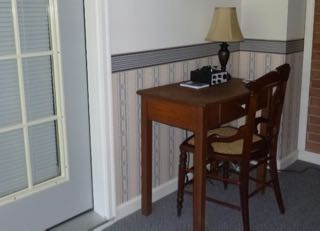
N5DRG: Yeah, its BUTT Ugly, and a bit stiff, but its just a Proto type that I built a couple of years back. Pine Board, Hack Saw Blade chopped down, a Pass Through Bolt connector, Rubber Pads, and some war, some folks call it Wire, but y'all know how it is being from down south, well some us'ns do. And the most important part other than it was all free, is that IT WORKS!!!!! Look out Home Brew Challenge 2015! Danny N 5 Dirty Rotten Grouch 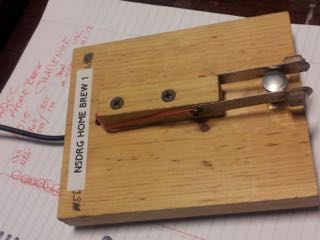
N1JI: I'm sending you some photos of the paper-clip paddles I used for this month's NAQCC challenge. I made them a couple of years ago for portable work and I've never gotten around to building an improved version. 73,Jock, 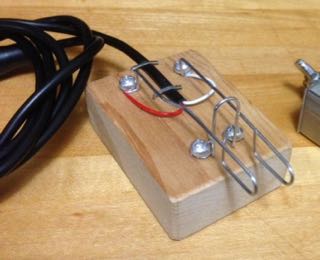
NQ2W: For the most part, this challenge is everyday radio for me. Every QSO I make involves some homebrewed piece of equipment. The QSOs I used to complete this challenge were made using my self-constructed K1 running 5 watts to antennas supported by my homebrewed quad-legged roof-top tower. I keyed the K1 using a LogiKit CMOS-4 keyer that I built. The iambic paddle I used (see picture) was designed and built by me...the goal - lightweight - think Spartan Sprints - and light touch keying. The mostly plastic/PVC paddle employs magnetic repulsion to open the contacts. Works pretty well and cost about $5 to make. Oh yeah...the headphones I use are noise-reducing Husqvarna ear muffs that I converted by installing some small junkbox speakers - work like a dream - no outside noise - just the sweet sound of CW. Gotta love this ham radio stuff...thanks to all for the opportunity. 72, Will 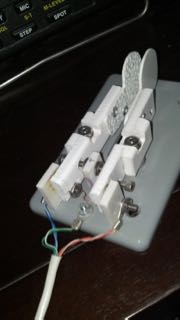
MW0RSS/A: I had a great time doing this challenge over a couple of evenings, operating /A from my girlfriend's house. The antenna was a length of wire tied to her blossom-covered apple tree. I used 5W from my lovely Ten-Tec Century 22, and a straight key. My homebrew equipment is an L-match for random wires, which I built into an old 'Scooper' SWR / ATU intended for CB use. I just pulled out the CB matching circuitry and used the chassis holes for my own purposes using components from my junk box, so the ATU cost me nothing. KA4WJB: This is a photo of my home brew 40 meter transmitter made of junk box parts. The tube is a 117L7 which has a half wave rectifier. I fed 120 volt AC into the rectifier and then fed the DC through filter to the plate of the tube. The coil is wound around a pill bottle and I put a neon pilot light for a little more glow. Output is about 1 watt. I'm using an isolation transformer on the AC input for a little more safety. As of now I only have 3 crystals so contacts are slow going. Hoping to get to 10 before the end of the month. Joey, KA4WJB 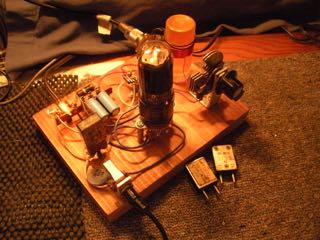
N0WKZ: The tuner itself is contained in what used to be an MFJ 202B noise bridge that was not functioning correctly. Since it already had the RF input connector and a 150 pF variable capacitor, I figured it would work nicely. All the other parts are scavenged, Elmer hand-me-down, found, ect. The magnet wire is from an old television CRT. There is no set design. It was made on the fly using my own intuition and using my other Home Brew 40 meter half wave tuner as a cookie cutter model. Despite the fact that I have practiced CW for two years, I am very inexperienced due a lack of live operating most of the time. So, the monthly challenge was just what the CW doctor called for. Each of the ten QSO's was made with the invisible badge of courage on my chest and shaky fingers on my key. I had a ball. I am so inexperienced but was graced with a few DX contacts with operators kind enough to give me the chance. I also call those "accidental DX" since I just happened to be on when those guys could be heard. Most of the other contacts were of the garden variety QRP "be patient with me" type. A few times I was too stiff from sitting on the grass to carry on very long, or, I was racing rain clouds and great big scary drops of warning rain hitting my exposed rig as I catch that cool smell of a coming storm accompanied by that tell tale cool sudden breeze. Yikes! I had hoped to prove out the tuner on each of the bands it can tune but that did not work out since I must work with my ability to go portable, and both WX & Solar WX. I rarely get all three to match up for one of those magic days where all the bands are teaming with life. In a nutshell however, each of the ten QSO's was GREAT, great fun. 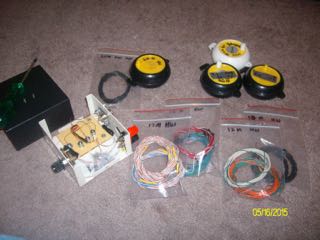
PA0XAW: For this month challenge I used my homebrew CW transceiver for 14 MHz. The design is from DL1HAU and appeared in CQ-DL of May 1987. The magazine is old, but the trx is 10 years young. Output is 4 watt into a home made 20 meter dipole antenne. Used my Heathkit keyer (build in 1974) to produce the morse code. N8XMS: With my Kit-built Elecraft K2 and KX1 radios and my kit-build Black Widow paddle every QSO is a home-brew challenge for me so this should have been an easy month for me. It wasn't! I've just been too busy to get on the air and I didn't get my 10th QSO until the 24th of the month. W2JAZ: Using a companion 40 meter RX/TX and frequency counter designed as a club project for members of the South Jersey Radio Association by Maria Dianora (N2AK), I made a surprising 20 QSOs. Stations logged represented 9 states, Canada and the Czech Republic. I operated for no more than an hour or so a day over an 8 day period from May 6-25. I'm hooked and ready to build something else that will get me on another band like 30 or 20 meters! 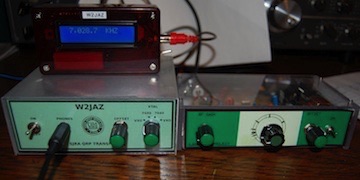
WA8AXF: All of my HF QSOs are made with one of two HB antennas - A 130' long doublet fed with ladder line or a 20 meter vertically polarized delta loop. I enjoy building antennas from readily available materials. My next one is going to be a vertical using common plumbing fittings so it can be setup in the field for portable operations, and break down into pieces no longer than 30" to fit in one of those bags folding camp chairs come in. Dave K1IEE: Its great to use a HB or kit built rig. Every contact brings back wonderful memories of the early days, for me in the 60's with Heathkits and rigs made from old tube TV sets. Thanks to all 73 Dick PA1B: I built a 15" Cylinder Dipole, with two 500 ml energy drink cans and a 80 mm coil with 8 turns. Resonating at 16 MHz. With this antenna in the shack at 4 meters above ground, I made about 20 QSO's. With a symmetrical tuner, to 'de'tune the antenna, I made QSO's on 21 MHz (13), 14 MHz (6) and 7 MHz (2). Is it a good antenna? Most QSO's were made with QRP all over Europe. Three of the QRPp QSO's were 1000 Miles per Watt QSO's and one QSO was made with 3.6 watts with N1KWF over 3400 miles. I very much enjoyed the homebrew part of the May 2015 challenge. 73, Bert PA1B 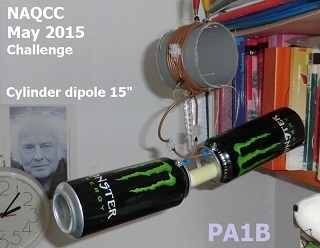
K1YAN : I made the required QSOs using my Small Wonder Labs DSW 40 and a New England QRP Club NEScaf audio filter. The DSW 40 runs about 2.5 watts out and is a synthesized rig. It is light and very stable with a built-in keyer and audible frequency readout. Lacking only AGC, it makes a great portable rig. Circa early 2000 and no longer available, I believe the kit came in 40, 30 and 20m models. The NAScaf kit is an outboard audio filter with a bandwidth of 1500 to 60 Hz, a 415 to 1000 Hz, continuously adjustable, center frequency and enough audio to drive a speaker. The board kit, still available from the NE QRP club for around $30, it is a good performer, a straight forward kit, and a small enough board ( around 2" square ) that it could be mounted in a QRP rig. The paddle is an old Jones Key that is about the same size as the rig and several times heavier. 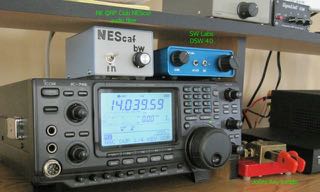
K0FNR: Various things kept me off the air this month, but, used parts laying around to fashion a key for the Challenge. Was able to get on for a few Sprint QSOs (not counting for the Challenge) in addition to a few Challenge QSOs and was pleased with the key. The key was fashioned from some discarded patio umbrella-rib tubing, spring, piece of hacksaw blade for the pivot (no sideways play), toilet bolt, knurled thumbscrew from light fixture, t-nut, radio knob, poker chip, L-shaped cup hook. 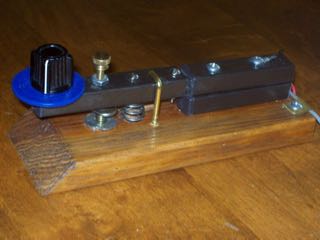
WB3T: Started the month with the first contact for my Splinter II QRPp Trans-Receiver, and the rest were done using my full-up K1. Thanks everyone, I'll try again! 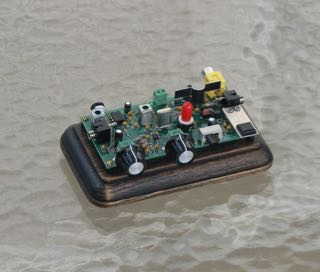
DH0DK: For this month challenge I used my homebrew longwire tuner for 80-10 m SW (Fuchs circle). The box is from MFJ Travel Tuner MFJ-902 and also the capacitor. Other parts of my junk box. The antenna is 21m long wire for 40m -10m and 42m long wire for 80m - 10m. So I work to field days of the mountains for SOTA WCA GMA and other activities. This combination is wonderful for outdoor. See my QSL card on qrz.com. I work on 01 May 10 stations and 3 May, 19 stations from the mountains. My station FT-817, 5 Watt, longwire 42m (01 May) and 21m long wire (03 May). A nice pleasure. Thanks to all 72 Ben #7576 W2JEK: To make the challenge more interesting I used 11 tranceivers for a total of 14 QSO'S. Used my Oak Hills OHR-500, OHR-40, and three OHR-100A rigs for 15, 20, and 30M. Also three Ten-Tec rigs - TT1380, TT1320, and TT1315. Next a 20M rig designed by Dave Benson K1SWL and kitted by Dan's Small Parts. Another rig was my Two-Fer, a multiband VXO XCVR designed by John KN1H [#1204] and Mike W3TS [#867]. Last was my first QRP rig, a HW-8. Also used were my OAK HILLS WM-2 wattmeter and DD-1 digitlal display. Had some great QSO'S. 72 and 73 Don Younger W2JEK #1135 AB9YC: I used my normal homebrew fan dipole for contacts on 40M-10M, and a homebrew inverted L for 80M; 17M seemed the most productive for this challenge. I constructed a homebrew paddle but it had some issues that made QSO's difficult; I reverted to my Bencher to make the QSO's. I had plans for portable operations which would have used my homebrew Z match tuner, but circumstances conspired against me. A fun challenge to get recognition of "built not bought" hardware. AK3X: This was an easy one since except for my little 4 amp PS, my entire station is comprised of monoband QRP kits built 15 or so years ago. Small Wonder Labs DSW rigs on 40/30/20, an MFJ 9317 Cub, and a KD1JV MS-15, along with my ZM-2 tuner and HB antenna. Although I am contemplating getting a new multiband rig, I am not sure I will get enough operating time to make the investment worthwhile... so for now I am happy with what I have. 72, Peter NAQCC 4825 |